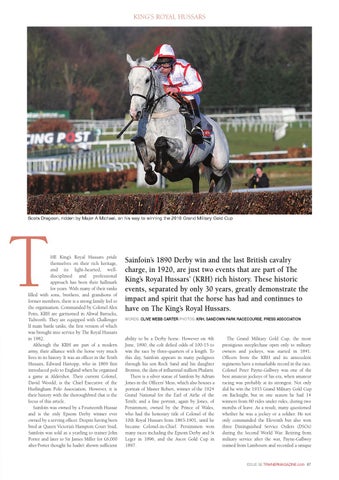KRH ISSUE 39_Jerkins feature.qxd 20/08/2012 09:33 Page 2
KING’S ROYAL HUSSARS
Scots Dragoon, ridden by Major A Michael, on his way to winning the 2010 Grand Military Gold Cup
T
HE King’s Royal Hussars pride themselves on their rich heritage, and its light-hearted, welldisciplined and professional approach has been their hallmark for years. With many of their ranks filled with sons, brothers, and grandsons of former members, there is a strong family feel to the organisation. Commanded by Colonel Alex Potts, KRH are garrisoned in Aliwal Barracks, Tidworth. They are equipped with Challenger II main battle tanks, the first version of which was brought into service by The Royal Hussars in 1982. Although the KRH are part of a modern army, their alliance with the horse very much lives in its history. It was an officer in the Tenth Hussars, Edward Hartopp, who in 1869 first introduced polo to England when he organised a game at Aldershot. Their current Colonel, David Woodd, is the Chief Executive of the Hurlingham Polo Association. However, it is their history with the thoroughbred that is the focus of this article. Sainfoin was owned by a Fourteenth Hussar and is the only Epsom Derby winner ever owned by a serving officer. Despite having been bred at Queen Victoria’s Hampton Court Stud, Sainfoin was sold as a yearling to trainer John Porter and later to Sir James Miller for £6,000 after Porter thought he hadn’t shown sufficient
Sainfoin’s 1890 Derby win and the last British cavalry charge, in 1920, are just two events that are part of The King’s Royal Hussars’ (KRH) rich history. These historic events, separated by only 30 years, greatly demonstrate the impact and spirit that the horse has had and continues to have on The King’s Royal Hussars. WORDS: CLIVE WEBB CARTER PHOTOS: KRH, SANDOWN PARK RACECOURSE, PRESS ASSOCIATION
ability to be a Derby horse. However on 4th June, 1890, the colt defied odds of 100-15 to win the race by three-quarters of a length. To this day, Sainfoin appears in many pedigrees through his son Rock Sand and his daughter Bromus, the dam of influential stallion Phalaris. There is a silver statue of Sainfoin by Adrian Jones in the Officers’ Mess, which also houses a portrait of Master Robert, winner of the 1924 Grand National for the Earl of Airlie of the Tenth; and a fine portrait, again by Jones, of Persimmon, owned by the Prince of Wales, who had the honorary title of Colonel of the 10th Royal Hussars from 1863-1901, until he became Colonel-in-Chief. Persimmon won many races including the Epsom Derby and St Leger in 1896, and the Ascot Gold Cup in 1897.
The Grand Military Gold Cup, the most prestigious steeplechase open only to military owners and jockeys, was started in 1841. Officers from the KRH and its antecedent regiments have a remarkable record in the race. Colonel Peter Payne-Gallwey was one of the best amateur jockeys of his era, when amateur racing was probably at its strongest. Not only did he win the 1933 Grand Military Gold Cup on Backsight, but in one season he had 14 winners from 80 rides under rules, during two months of leave. As a result, many questioned whether he was a jockey or a soldier. He not only commanded the Eleventh but also won three Distinguished Service Orders (DSOs) during the Second World War. Retiring from military service after the war, Payne-Gallwey trained from Lambourn and recorded a unique
ISSUE 39 TRAINERMAGAZINE.com 67
